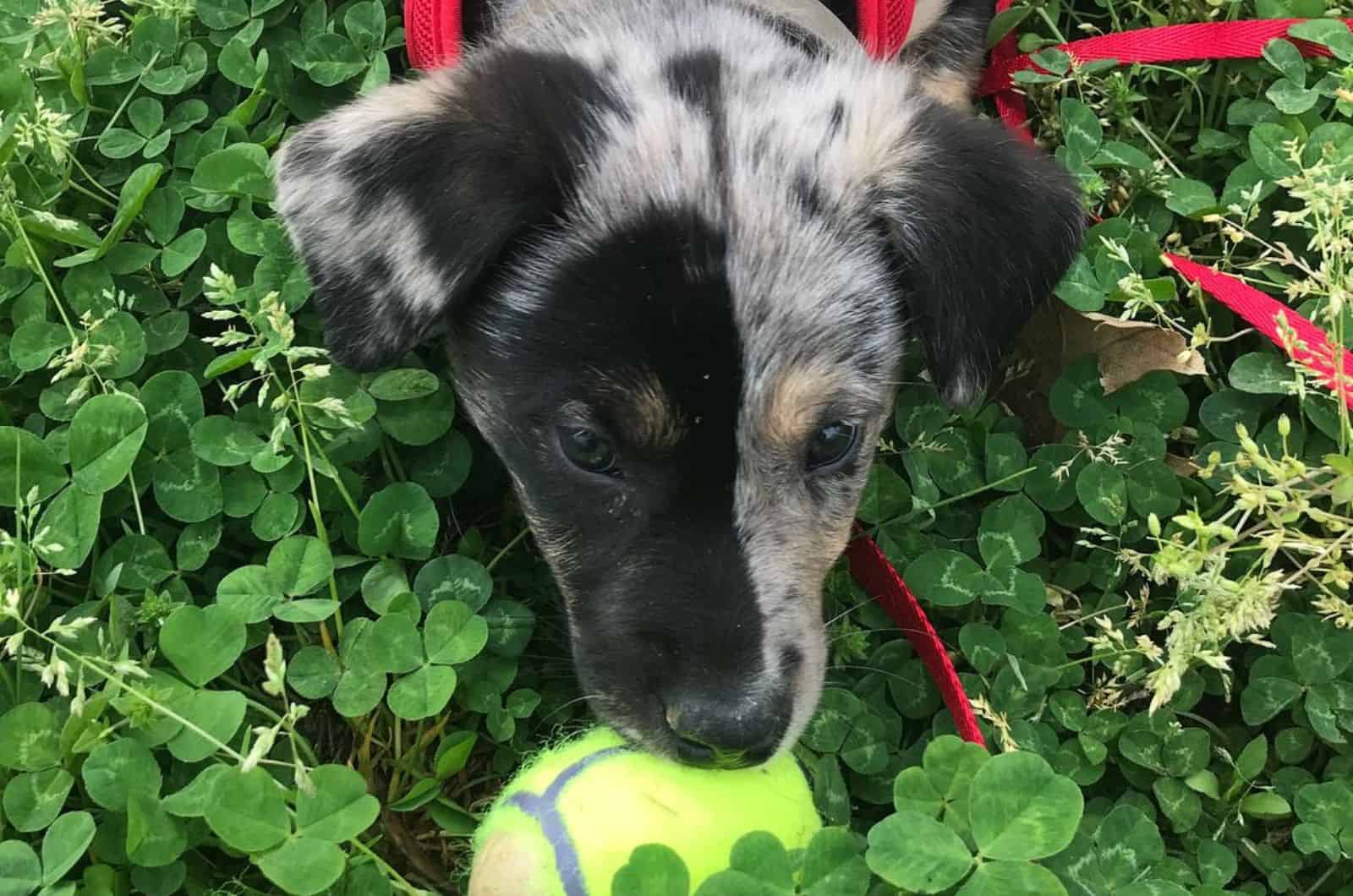There are plenty of wonderful Norwegian Elkhound mixes that will make you fall in love with them as soon as you see their cute faces in person.
Norwegian Elkhounds are quite an uncommon dog breed in the United States, although they are becoming more and more popular (in a few years, they might become a common family pet).
They possess great qualities, and when you mix them with the qualities of other dog breeds, you can count on a powerful yet loyal furry friend who will always be there to watch your back.
However, don’t let the looks fool you, as even the “toughest” pups from this list love to cuddle and act like lap dogs.
Norwegian Elkhound Mixes
1. Elk-A-Bee (Beagle And Norwegian Elkhound mix)
Both male and female Beagle pups can be bred with Norwegian Elkhound dogs in order to create this unusual designer dog breed of medium to large size.
You can expect a pup with high energy level and prey drive, as both of these purebred dogs belong to the category of hunting canines, although they’re known as family pets today.
When it comes to coat types and shades, your pup might be covered in any of the Norwegian Elkhound or Beagle colors. The same goes for the type of fur, which can be either short or long-haired.
Unfortunately, none of them are hypoallergenic, so chances are high that your Norwegian Elkhound mix puppy won’t be either. Therefore, be prepared for quite a lot of dog hair on your furniture and yourself, as these pups love to cuddle a lot.
2. Norwegian Elkhound German Shepherd Mix
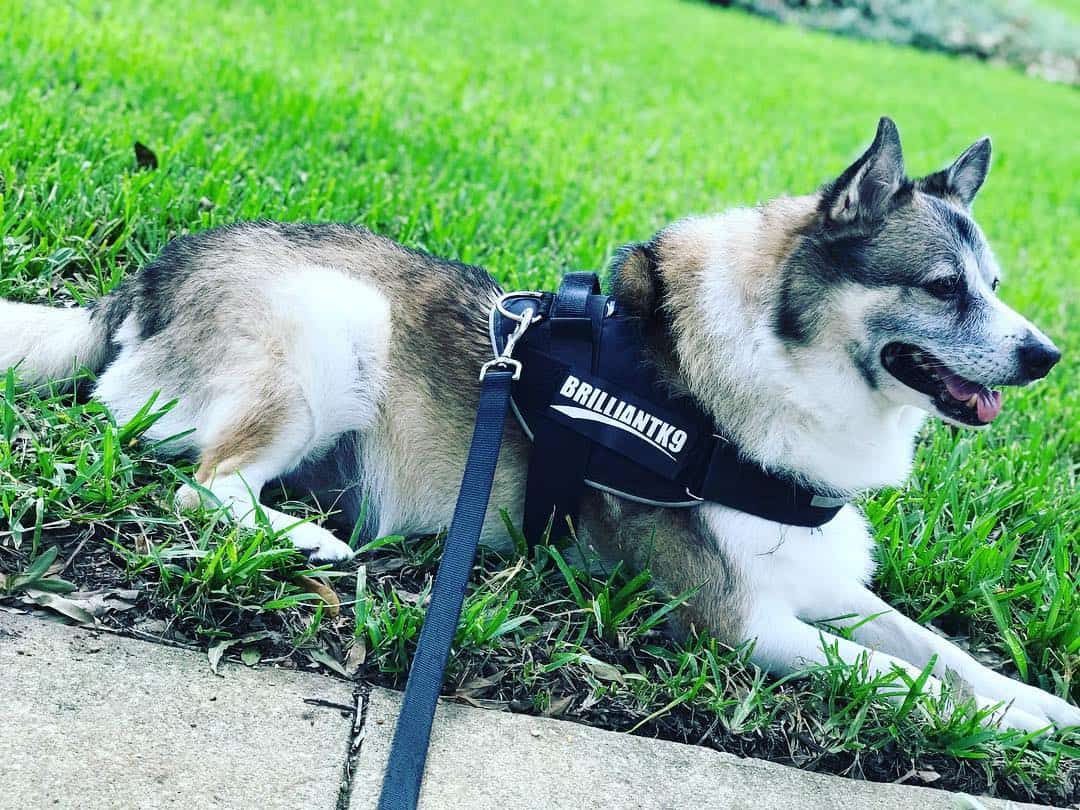
Photo from: @tine.tine0721
This is a very interesting cross between Norwegian Elkhound and German Shepherd dogs that share a few similarities, although they don’t belong to the same dog breed.
Both Norwegian Elkhounds and German Shepherds love to bark, and their crossbreed will probably be quite vocal as well. However, with proper training from early puppyhood, you’ll be able to solve this issue without any problems.
The crossbreed of these two dogs can be colored in either shade of the parent breeds, including black and tan, gray, and silver hues.
RELATED: German Shepherd Colors: 15 Shades That’ll Take Your Breath Away
The German Shepherd isn’t an aggressive pup, and neither is the Elkhound, so you don’t have to worry about their temperament. They might be a bit reserved towards strangers, but they’re very affectionate toward their owners and other family members.
That is why this mixed dog breed is considered a great watchdog and family dog.
3. Miniature Pinschelkhound (Miniature Pinscher And Norwegian Elkhound Mix)
This is a rather unusual mixed-breed dog that is the result of a crossing between the Norwegian Elkhound and Miniature Pinscher.
Their size can range depending on the genetic background of each pup, which is why some Mini Pinschelkhounds are small, and others are medium-sized pups.
Mini Pinschers have more colorful coats, including chocolate, tan, red, rust, and black, white Elkhounds usually come in charcoal-like shades such as grey and black (although white is quite common as well).
Therefore, you can expect your pup to have at least two shades intertwined, depending on the dominant color gene of the parent breeds.
When it comes to grooming, this type of crossbreed requires low to medium maintenance, although they can shed quite a bit, so make sure not to skip on the brushing sessions.
4. Siberian Husky Norwegian Elkhound Mix
Many will agree that this is one of the most interesting Norwegian Elkhound mixes, at least when it comes to their physical appearance, although other mixed breeds are just as wonderful.
The main difference between Siberian Huskies and Norwegian Elkhounds is their temperament, as Huskies are completely open to strangers (which is why they aren’t the best choice for guard dogs).
However, both of these canines are Spitz-type dogs, which explains their resemblance in physical appearance.
Their crossbred puppies can usually be found in white, black, and grey shades (or combinations of these colors).
Both male and female Siberian Huskies have double coats, just like the Norwegian Elkhounds, so there is a high chance your hybrid pup will have thick fur, too.
These pups are quite vocal too because of their parent breeds, as Elkhounds and Huskies like to howl and bark quite a lot.
5. Elk-Kee (Keeshond And Norwegian Elkhound Mix)
The Norwegian Elkhound and Keeshond were crossed to create the designer dog known as the Elk-Kee.
They are canines of medium size that can reach a weight of up to 45 lbs.
Their fur is expected to be short, dense, and silky, with typical hues being black, silver, greyish, or beige.
Keeshonds have been utilized as companion pups for a long time in the Netherlands, but they have become quite popular in other countries as well.
Although this isn’t a common mix, it’s not a big surprise either, as both of the parent breeds belong to canines of European origins.
This mixed breed doggy is fiercely energetic, so they need owners who are willing to spend a lot of time outside.
Considering that Keeshonds are easily trainable, there should be no big issues in training your crossbred pup either.
6. Norwegian Elkhound Corgi (Norwegian Elkhound And Corgi Cross)
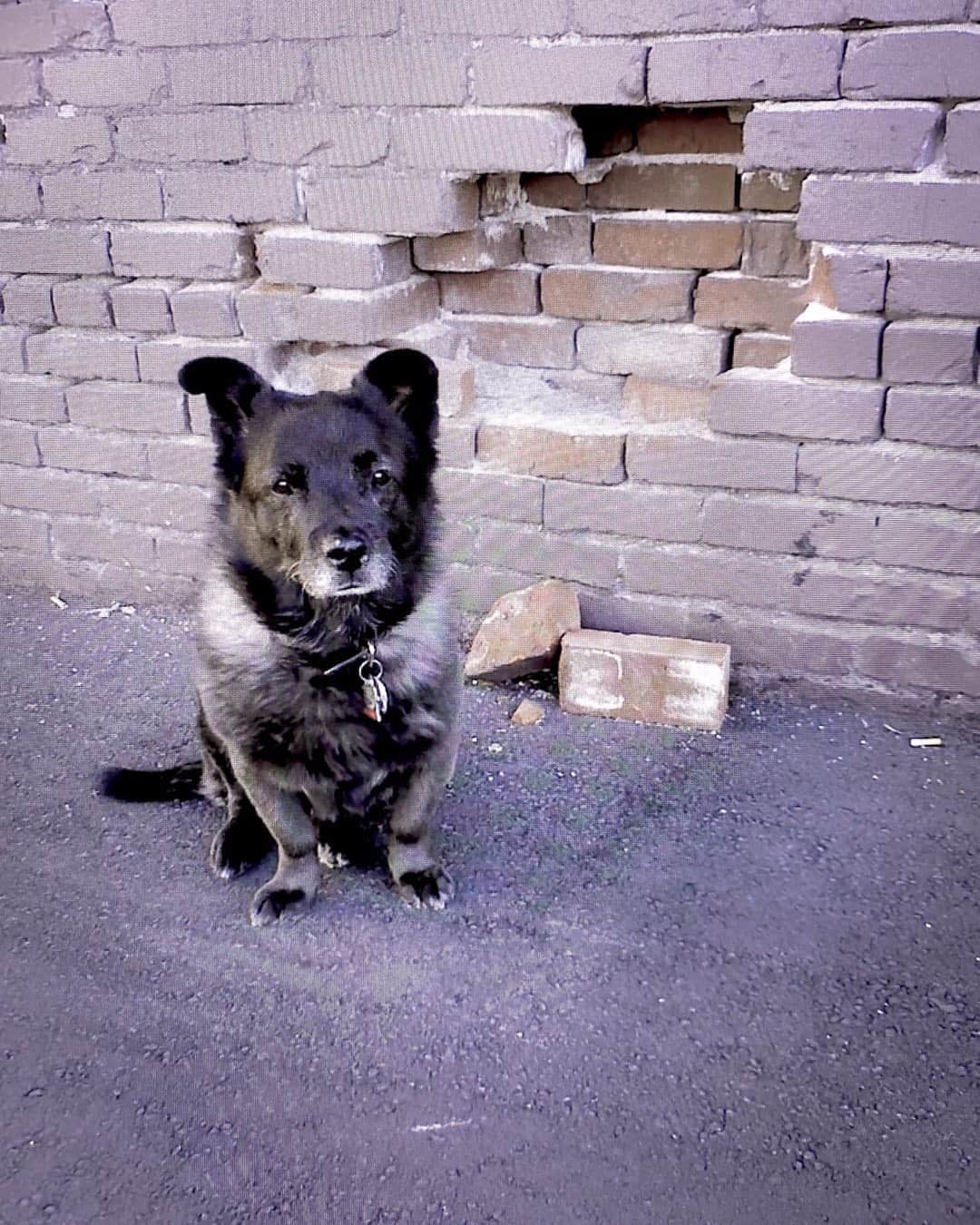
Photo from: @lacheraqui
What do you get when you combine one of the British canines with Norway’s national pup? A wonderful doggy that contains the best qualities of both its parent breeds.
This mixed breed pup usually inherits the physical appearance of Corgis, especially when it comes to their height and weight.
However, there are high chances that these pups will inherit the color gene from Norwegian Elkhounds, so this might be one of the rare times you get to see a black-greyish Corgi-like pup.
On the other hand, Corgis aren’t hypoallergenic, just like the other parent breed, so I wouldn’t recommend getting their mix as a pet if there are people with severe allergic reactions in your household.
Regarding their temperaments, these two breeds aren’t very different, although Norwegian Elkhounds aren’t that fond of strangers, like the other side.
Still, both Elkhounds and Corgis are really good with children, which is why their crossbreed can be used as a family pet.
7. Border Collie Norwegian Elkhound Mix
Border Collies aren’t usually considered overly aggressive pups, but they aren’t the best choice for inexperienced dog owners, and neither are their combinations with other dogs, although the Elkhounds are friendly enough to be pets to first-time dog owners.
Both male and female BCs are herding dogs, and they possess great qualities that combine well with the traits of Elkhounds, which are known as hunting dogs. Their crossbreed will end up being a medium-sized canine with excellent herding skills and high prey instinct.
On the other hand, Collies bark quite a lot, which isn’t much of a surprise, considering that they were primarily bred for herding.
If you mix that with Norwegian Elkhound vocal abilities, you can expect a mixed breed doggie with a powerful “woof”.
However, that won’t stop you from loving them, especially when you see their cute faces that remind of BCs, although it’s usually covered in Norwegian Elkhound shades.
8. Alaskan Malamute And Norwegian Elkhound Cross
This is one of the most interesting Alaskan Malamute crosses that combines the beautiful fluffy coat of this dog breed with the silvery shades that are typical of Norwegian Elkhounds.
Both of these canines are wonderful animals that will serve as loyal and affectionate furry companions for the whole family, including children.
Their hybrid pup shares all of these qualities, as they have proven to e good guard dogs but also furry buddies to the youngest members of the family, although many people are skeptical of leaving them with kids because of the canine’s size.
However, both parent breeds and crossbreeds require socialization training from early puppyhood, or else they might act reserved to strangers or even hostile in some cases (only if they feel threatened).
Alaskan Malamutes are indeed large dogs, and the majority of their crossbreeds resemble them, especially when it comes to their weight (male purebred Malamutes can go up to a whopping 200 lbs).
You should prepare well for owning one of these hybrid pups, as they require regular grooming, especially if they inherit the coat type from their Malamute parents.
9. Blue Heeler Norwegian Elkhound Cross
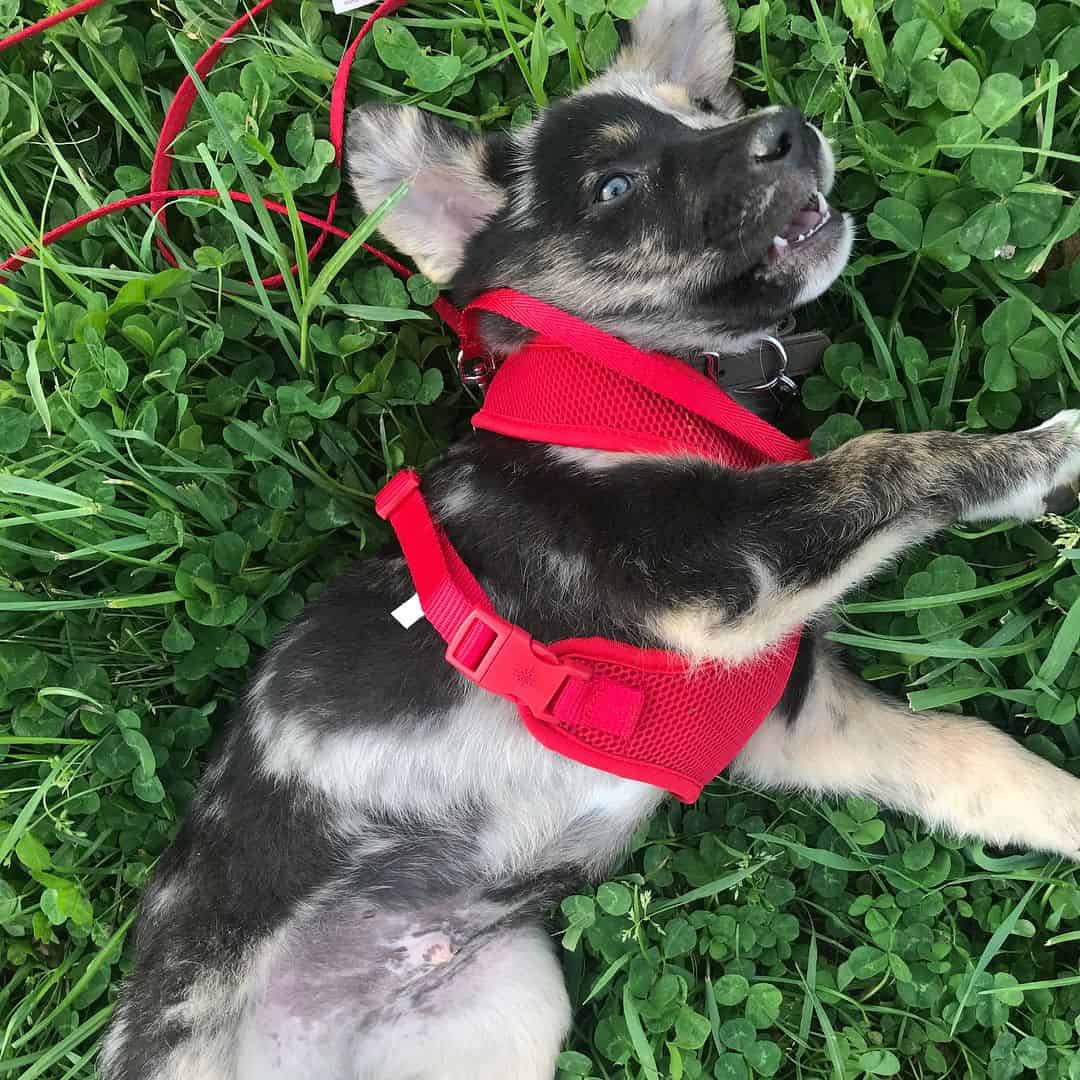
Photo from: @livvmore_equestrian
Blue Heelers are a fascinating dog breed with a rich history and several names (Queensland Heeler or Australian Cattle Dog), and the Viking dogs (Elkhounds) share an equally magnificent historic background as well.
Therefore, you can expect nothing less than a wonderful mixed breed pup with excellent traits from both parent breeds (and their ancestors).
In terms of physical appearance, it’s noticed that Blue Heelers grow up to 21 inches, almost the same as Elkhounds, so their mixed breed probably won’t go over 20 inches in height either.
However, don’t mix up Red and Blue Heelers, as these two are officially different types of canines, although they belong to the same breed (the only difference is in their coat shade).
Still, it’s important to mention this detail as it explains why most Blue Heeler mixes inherit black and tan, black, or greyish coat hues.
Either way, I’m sure that by crossing a Norwegian Elkhound with an Australian Cattle dog, you’ll get a high-quality dog of excellent health and solid temperament.
10. Great Pyrenees Norwegian Elkhound Cross
This is probably one of the most challenging crosses between an Elkhound and any other pup on the list. The main reason for that is the fact that Great Pyrs are excellent pups but very strong-willed and unfriendly to strangers.
However, this type of issue can be resolved in several steps, including taking a pup from a reputable breeder and properly socializing it (training, playtime in dog parks, etc.).
RELATED: Great Pyrenees Training Tips You Didn’t Know You Needed
Still, this is one of the main reasons why these pups, and their mixes, including the one with the Norwegian Elkhound, aren’t recommended for dog owners without previous experience with canines, especially large pups with a strong will.
Pyrs will shed only occasionally (during certain seasons), which is why their cross with the Elkhound is considered a moderate shedder as well. Because of that, it doesn’t require any special treatments or additional time during grooming sessions.
11. Aussie Elkhound (Australian Shepherd and Norwegian Elkhound Cross)
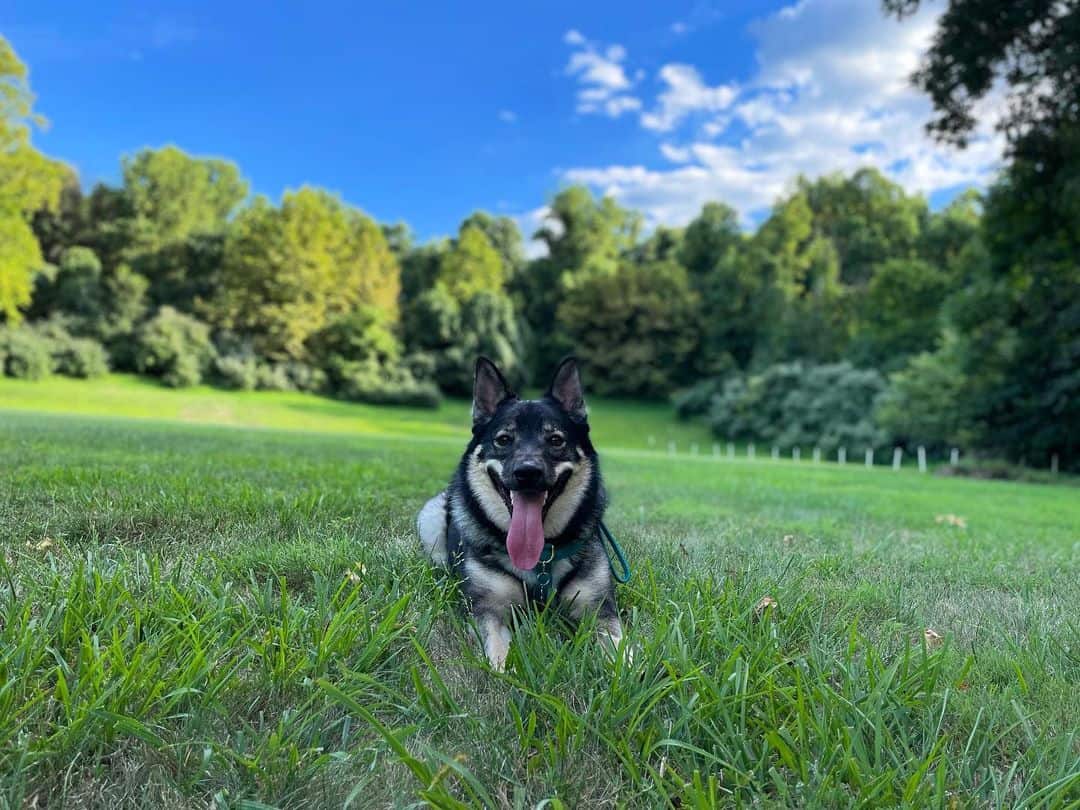
Aussies are one of the most popular dog breeds, especially among service canines, watchdogs, or search and rescue dogs, because of their excellent skills and good behavior.
Male and female Australian Shepherds are excellent dogs for crossbreeding, as they possess a high number of qualities, including their ability to excel at terrain work and also as a great family pet.
Aussies are excellent with kids, even better than the Norwegian Elkhound, so you can expect your mixed breed pup to be just as lovable and affectionate as these two parent breeds.
When it comes to their size, both parent breeds share similar traits, including their growth and weight. Some might consider them as large canines, but they’re better described as medium-sized dogs with sturdy and powerful bodies.
Aussies come in several different colors, including black, blue merle, red tri, black tri, red merle, merle, and red. Norwegian Elkhounds are usually found in a range of black and grey shades.
Therefore, if you want to own an Aussie Elkhound cross, you can only hope that the Aussie’s color gene will be more dominant until the puppies are born, and you finally see them.
12. Rottweiler And Norwegian Elkhound Mix
Rotties are indeed one of the canine breeds that often seem dangerous and aggressive because of their appearance, although their temperament is quite the opposite of the way they look.
Rotts are great with children and adults, and the only time they might appear hostile is when they feel threatened by someone or something.
They share quite a lot of similarities with Elkhounds regarding their temperament, which is why their cross is usually described as affectionate, obedient, and protective of their owners.
The Rottweiler Elkhound cross shouldn’t be too demanding when it comes to grooming, as both parent breeds are considered moderate shedders.
When it comes to trainability, these crossbred pups won’t show much resistance to the commands that come either from their owners or professional dog trainers.
13. Chihuahua And Norwegian Elkhound Mix
This is probably one of the most unusual mixes on this list, which might seem almost impossible to imagine at first. However, this type of canine does exist, and many will agree that it’s simply adorable.
Chihuahuas are small pups with bold personalities, which is why some might not consider them to be the best option for crossbreeding, as you never know what you’re going to get.
However, Elkhounds are much less aggressive than Chihus, so there are good chances that their cross pup will inherit the temperament from the Norwegian Elkhound.
As mentioned above, Elkhounds usually don’t have a great range of coat shades available, but their crossbreed might inherit the hues from the other parent breed.
Chihus are generally covered in shades and patterns such as black, chocolate, cream, white, fawn, merle, or gold, so there are certain chances that your pet might be covered, at least partly, in one of these shades.
It’s also important to mention that Chihuahuas live longer than other breeds, as their lifespan might be up to 20 years. Therefore, you won’t have to worry about the life expectancy of your new pup for a long time.
14. Labrador Retriever And Norwegian Elkhound Cross
The calm nature of the Elkhound Lab makes it ideal for them to be family pets.
These canines exhibit good character, devotion, and a bright, joyful demeanor.
These pups are fiercely devoted to their family, yet they are typically reserved with strangers until they get to know them.
These pups are now highly regarded as furry buddies because of their affectionate, perceptive, and watchful demeanor.
Both female and male Labs are energetic pups that will be happy if they receive love, affection, and lots of cuddles, but they also require time for outside exercise. The same goes for their crossbreeds that have a high level of physical activity.
The first color that comes to mind when you hear the expression “Labrador” is probably cream or white, although they can be covered in other shades as well, including fox red, charcoal, chocolate, and other colors.
RELATED: Top 5 Best Fox Red Labrador Breeders In The U.S.
15. Norwegian Elkipoo (Poodle Norwegian Elkhound Mix)
This is one of the sweetest crosses on our list, which combines two wonderful breeds, Norwegian Elkhound and a Standard Poodle, into a mixed dog breed known as the Norwegian Elkipoo.
A Norwegian Elkipoo tends to be an active, playful, and loving dog that forms strong ties with families, despite the fact that a mixed breed might acquire any combination of features from both of its parents.
Poodle mixes usually take on the physical appearance of this parent breed, especially when it comes to the type of coat and fur shades.
Poodles can come in a variety of hues and coat patterns, including merle, phantom, parti, black, blue, red, apricot, white, and others.
These pups have a history as both working and hunting dogs. When engaged in a job, they frequently exhibit seriousness, concentration, and determination.
They typically get on well nicely with kids and canines of different species.
They may require extra education and coaching with other smaller animals in the home because they have a high hunting instinct and impulse to catch.
16. Pug And Norwegian Elkhound Mix
Here is another rather unusual but still adorable cross between a small canine, Pug, and a big Norwegian Elkhound, which looks really cute in Pug’s colors.
This type of mixed breed is quite unpredictable, as there’s no guarantee which of the parent breeds they will resemble more, but there are certain chances that these canines will grow to become medium-sized hybrid dogs with a mixed appearance of both breeds.
However, what we can tell is that these pups will surely have fewer health issues, at least when it comes to skin problems that are common in Pugs.
This is mainly because Pug mixes usually have fewer folds and wrinkles over their bodies than purebred pups.
This type of designer dog breed is suitable for families that have children, as they’ll surely get along well.
However, Pugs aren’t the most inexpensive breed, and this isn’t a common cross, so you can expect the price to be much higher than in other crosses.
17. Golden Retriever And Norwegian Elkhound Cross
Last but not least comes one of the most popular dog breeds in the world, Golden Retrievers! What would a list of mixed-breed puppies be without this famous dog breed?
Goldens are known as the best dogs for almost everything, from family pets to babysitters and even working dogs (a role they usually had in the past).
These pups excel at everything, so it would be a shame not to use their qualities to create the designer dog breed of your dreams.
When you mix these traits with the wonderful characteristics of Norwegian Elkhound, you know you’re in for a treat.
In terms of physical appearance, these two dog breeds are quite similar (weight and height), but Goldens have a wider range of shades that are much brighter than the Elkhound ones.
Of course, no one can claim in advance which colors puppies will inherit, but they usually come as a mix of both.
Norwegian Elkhound Characteristics
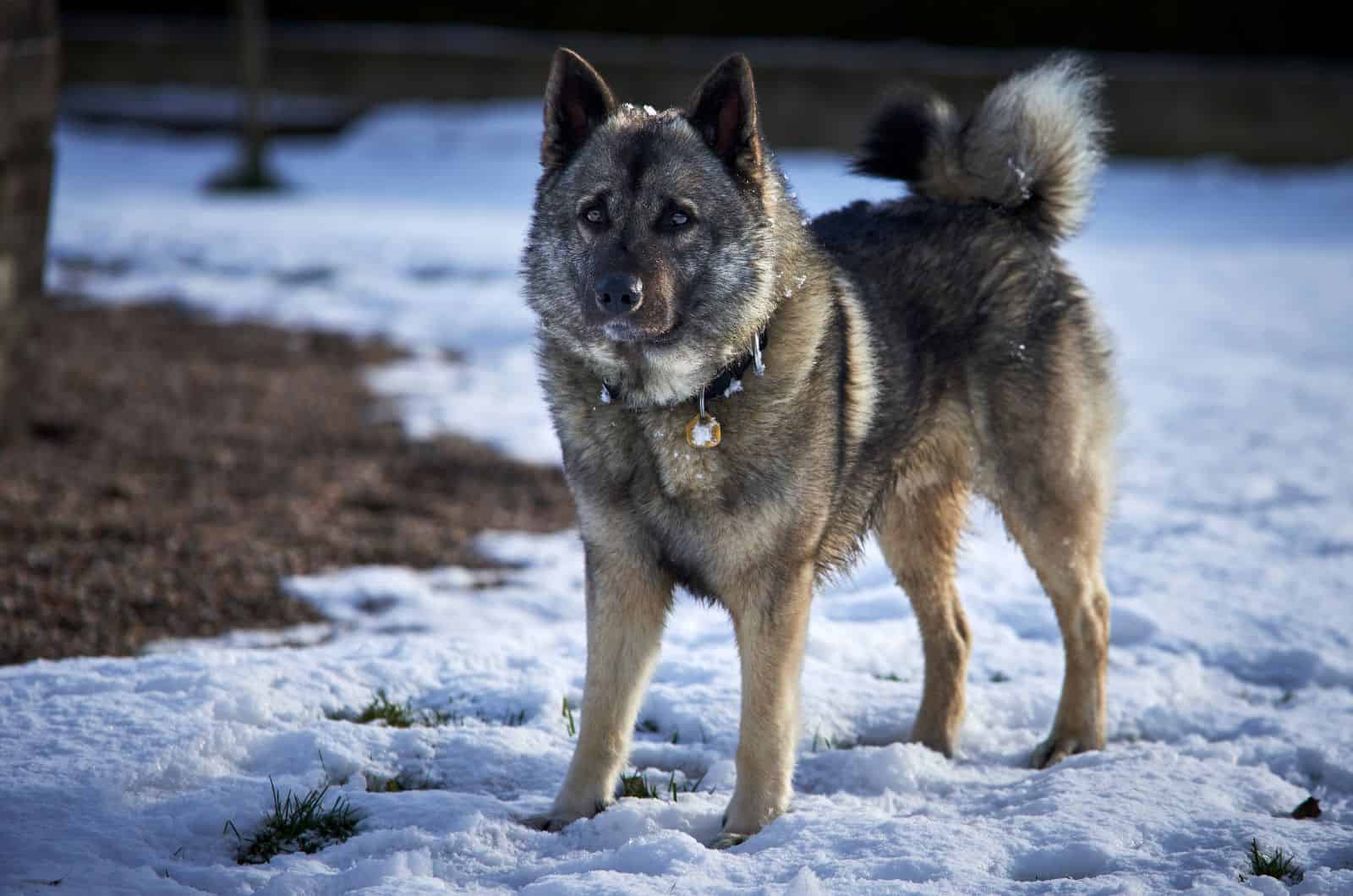
Although we already learned a lot about this dog breed through the list of its mixes, it’s important to mention several facts that might have an impact on their mixed breed doggies.
This type of dog is considered to be ancient because it first appeared in 5000 B.C. as a hunting canine. Nowadays, they are recognized by the American Kennel Club (AKC) as purebred canines that comply with their standards.
It’s considered a National Dog Of Norway, its motherland, although they’re becoming more and more popular in other parts of the world as well.
These pups are obedient and loyal to their owners, but they’re also fiercely energetic and love to spend time outside the house.
However, this Spitz-type of dogs can also become suspicious of any new human or animal faces that they might come across for the first time.
Just like any other breed, this type of canine also comes with certain health issues, which will be explained in the next few paragraphs.
Health Issues Of Norwegian Elkhounds
• Elbow Dysplasia – In young dogs of huge and gigantic breeds, the most prevalent cause of forelimb lameness is a condition known as elbow dysplasia.
The vast majority of canines have a limp on either one or both of their front legs. When the good leg is under pressure, there can be a slight bow movement, and when the affected leg is placed, this can be perceived as an involuntary moment of raising the head.
Exercise and relaxation for an extended period of time might frequently lead to lameness. Because of this, many canines will hobble when they first wake up, but after heating up with some activity, they will be able to run easily, only to limp again thereafter.
• Fanconi syndrome – This term implies a faulty activity of the tubules, which are one of the vital parts of the kidneys.
When a dog has this illness, the tubules do not reabsorb electrolytes and micronutrients in the correct manner. As a result, the tubules “spill” these substances back into the urine, where they are then eliminated.
The most prevalent symptoms are excessive urination and constant thirst. Even if they continue to eat regularly, dogs with this health condition may experience significant weight loss.
As the illness continues, the canines affected will experience a deterioration in their bodily condition, as well as a possible loss of appetite and lethargic behavior.
• Hip Dysplasia – Hip dysplasia is a common skeletal disorder that is most typically observed in large or giant breed dogs. However, it is possible for smaller breeds to be affected as well. The condition can also occur in humans.
The owners first need to have a fundamental understanding of the anatomy of the hip joint so that they may comprehend how the issue operates.
The ball and socket structure may be observed in the hip joint. When a dog has hip dysplasia, the ball and socket do not fit together properly and do not grow normally. As a result, they grind and rub against one another instead of moving smoothly.
This causes the joint to deteriorate over time, which ultimately leads to the joint’s inability to perform its intended function.
• Progressive Retinal Atrophy (PRA) – PRA is a kind of canine blindness that is caused by a hereditary condition. Labrador Retrievers, Poodles, Norwegian Elkhounds, Cocker Spaniels, and Blue Heelers, and many other breeds are affected by this disease.
Night blindness is one of the first symptoms that may appear in a dog suffering from progressive retinal atrophy (PRA).
It’s possible that these dogs might be afraid of going outside at night, that they’ll only go out if the light is on, that they don’t notice certain objects if it’s dark out, or that they have an increased amount of green or yellow reflection coming out of their eyes when it’s dark out.
• Hypothyroidism – Dogs frequently suffer from the endocrine condition known as hypothyroidism, which causes a reduction in the body’s synthesis of thyroid hormones.
In most cases, inflammation of the target organs or degradation (deterioration) of the glands can be found in canines that suffer from hypothyroidism. Thankfully, canines do not frequently get thyroid cancers as humans do.
When it does take place, hypothyroidism is more frequent in dogs who are middle-aged, and dogs of medium-to-large breeds are more likely to be impacted by the condition.
The Golden Retriever, the Doberman Pinscher, the Norwegian Elkhound, the Dachshund, the Miniature Schnauzer, the Cocker Spaniel, and the Irish Setter are some of the breeds that are more prone to this condition.
Wrapping Up
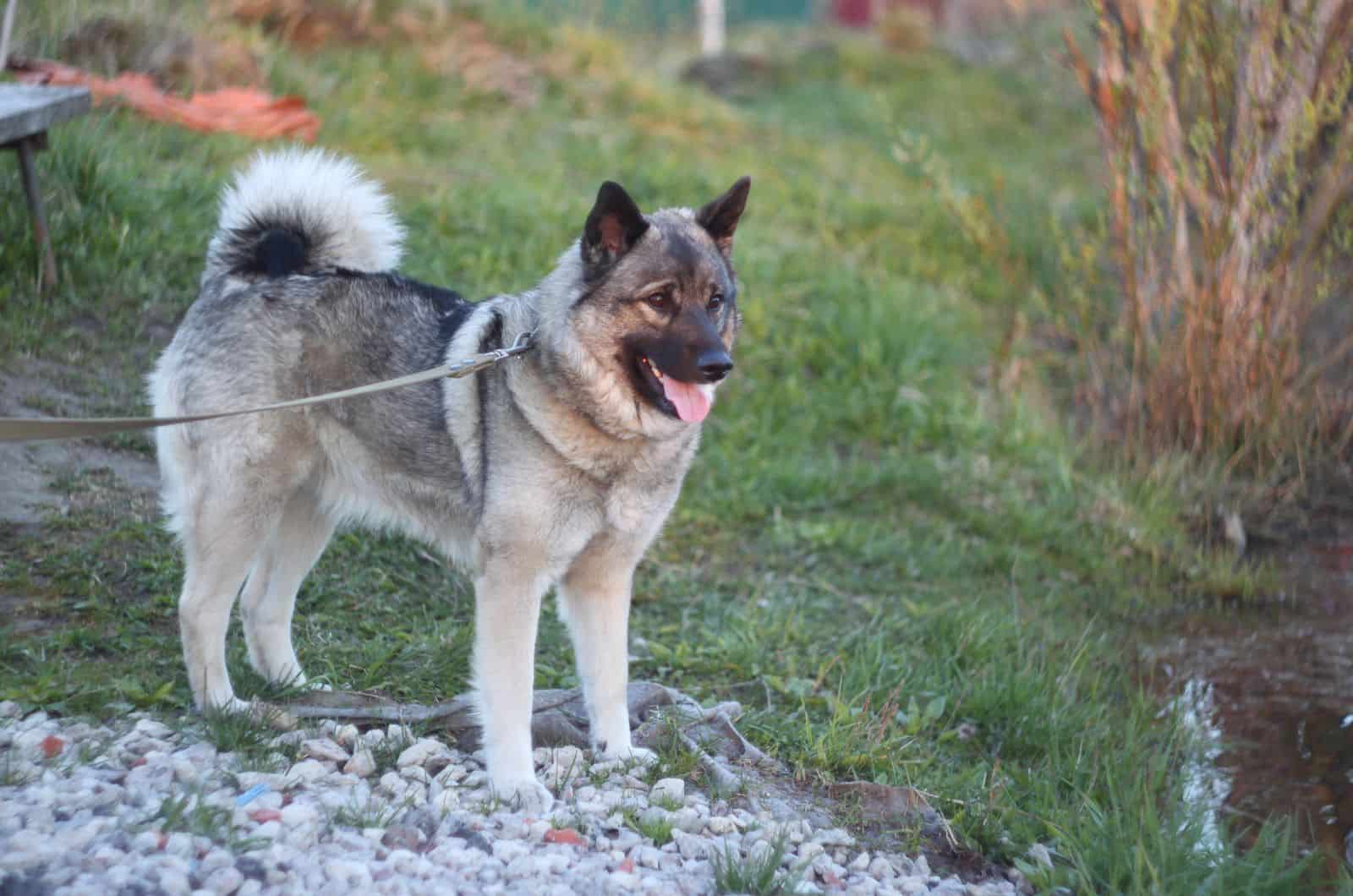
I hope you enjoyed going through our list of the Norwegian Elkhound mixes. These pups are indeed wonderful beings that can be great family companions, guard dogs, and working canines.
The versatility of these hybrid dogs is seen through the various dog breeds that the Norwegian Elkhound can be crossed with. Some might have come as a bit of a surprise, but they’re nothing less amazing than other crossbreeds.
I hope that this article helped you make the final decision on which mixed breed pup would suit you the best, depending on your personal preferences.
However, if you plan on adopting a pup from a professional breeder, you should definitely make sure to get one from a trustworthy person with experience in breeding Norwegian Elkhound mixes.
READ NEXT:
How Often Should You Bathe A Golden Retriever: All You Need To Know
28 Poodle Haircuts That Will Make Your Pet Even Sweeter!
Australian Shepherd Feeding Chart: How Much Should Aussies Eat?
